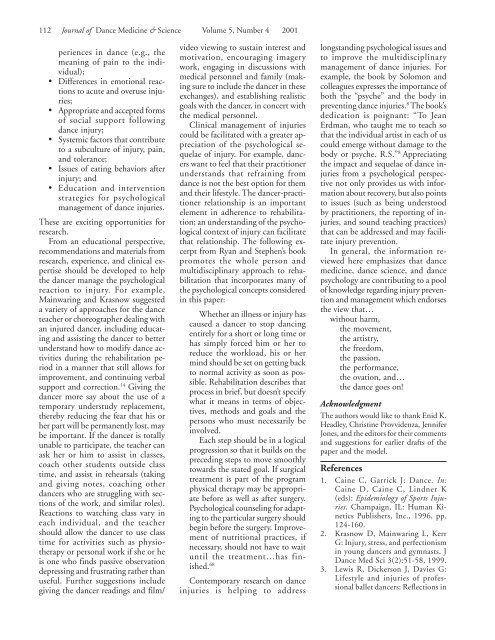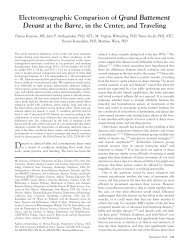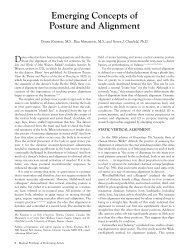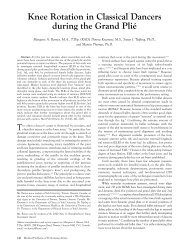And the Dance Goes On - Conditioning-with-Imagery
And the Dance Goes On - Conditioning-with-Imagery
And the Dance Goes On - Conditioning-with-Imagery
Create successful ePaper yourself
Turn your PDF publications into a flip-book with our unique Google optimized e-Paper software.
112 Journal of <strong>Dance</strong> Medicine & Science Volume 5, Number 4 2001<br />
periences in dance (e.g., <strong>the</strong><br />
meaning of pain to <strong>the</strong> individual);<br />
Differences in emotional reactions<br />
to acute and overuse injuries;<br />
Appropriate and accepted forms<br />
of social support following<br />
dance injury;<br />
Systemic factors that contribute<br />
to a subculture of injury, pain,<br />
and tolerance;<br />
Issues of eating behaviors after<br />
injury; and<br />
Education and intervention<br />
strategies for psychological<br />
management of dance injuries.<br />
These are exciting opportunities for<br />
research.<br />
From an educational perspective,<br />
recommendations and materials from<br />
research, experience, and clinical expertise<br />
should be developed to help<br />
<strong>the</strong> dancer manage <strong>the</strong> psychological<br />
reaction to injury. For example,<br />
Mainwaring and Krasnow suggested<br />
a variety of approaches for <strong>the</strong> dance<br />
teacher or choreographer dealing <strong>with</strong><br />
an injured dancer, including educating<br />
and assisting <strong>the</strong> dancer to better<br />
understand how to modify dance activities<br />
during <strong>the</strong> rehabilitation period<br />
in a manner that still allows for<br />
improvement, and continuing verbal<br />
support and correction. 14 Giving <strong>the</strong><br />
dancer more say about <strong>the</strong> use of a<br />
temporary understudy replacement,<br />
<strong>the</strong>reby reducing <strong>the</strong> fear that his or<br />
her part will be permanently lost, may<br />
be important. If <strong>the</strong> dancer is totally<br />
unable to participate, <strong>the</strong> teacher can<br />
ask her or him to assist in classes,<br />
coach o<strong>the</strong>r students outside class<br />
time, and assist in rehearsals (taking<br />
and giving notes, coaching o<strong>the</strong>r<br />
dancers who are struggling <strong>with</strong> sections<br />
of <strong>the</strong> work, and similar roles).<br />
Reactions to watching class vary in<br />
each individual, and <strong>the</strong> teacher<br />
should allow <strong>the</strong> dancer to use class<br />
time for activities such as physio<strong>the</strong>rapy<br />
or personal work if she or he<br />
is one who finds passive observation<br />
depressing and frustrating ra<strong>the</strong>r than<br />
useful. Fur<strong>the</strong>r suggestions include<br />
giving <strong>the</strong> dancer readings and film/<br />
video viewing to sustain interest and<br />
motivation, encouraging imagery<br />
work, engaging in discussions <strong>with</strong><br />
medical personnel and family (making<br />
sure to include <strong>the</strong> dancer in <strong>the</strong>se<br />
exchanges), and establishing realistic<br />
goals <strong>with</strong> <strong>the</strong> dancer, in concert <strong>with</strong><br />
<strong>the</strong> medical personnel.<br />
Clinical management of injuries<br />
could be facilitated <strong>with</strong> a greater appreciation<br />
of <strong>the</strong> psychological sequelae<br />
of injury. For example, dancers<br />
want to feel that <strong>the</strong>ir practitioner<br />
understands that refraining from<br />
dance is not <strong>the</strong> best option for <strong>the</strong>m<br />
and <strong>the</strong>ir lifestyle. The dancer-practitioner<br />
relationship is an important<br />
element in adherence to rehabilitation;<br />
an understanding of <strong>the</strong> psychological<br />
context of injury can facilitate<br />
that relationship. The following excerpt<br />
from Ryan and Stephen’s book<br />
promotes <strong>the</strong> whole person and<br />
multidisciplinary approach to rehabilitation<br />
that incorporates many of<br />
<strong>the</strong> psychological concepts considered<br />
in this paper:<br />
Whe<strong>the</strong>r an illness or injury has<br />
caused a dancer to stop dancing<br />
entirely for a short or long time or<br />
has simply forced him or her to<br />
reduce <strong>the</strong> workload, his or her<br />
mind should be set on getting back<br />
to normal activity as soon as possible.<br />
Rehabilitation describes that<br />
process in brief, but doesn’t specify<br />
what it means in terms of objectives,<br />
methods and goals and <strong>the</strong><br />
persons who must necessarily be<br />
involved.<br />
Each step should be in a logical<br />
progression so that it builds on <strong>the</strong><br />
preceding steps to move smoothly<br />
towards <strong>the</strong> stated goal. If surgical<br />
treatment is part of <strong>the</strong> program<br />
physical <strong>the</strong>rapy may be appropriate<br />
before as well as after surgery.<br />
Psychological counseling for adapting<br />
to <strong>the</strong> particular surgery should<br />
begin before <strong>the</strong> surgery. Improvement<br />
of nutritional practices, if<br />
necessary, should not have to wait<br />
until <strong>the</strong> treatment…has finished.<br />
68<br />
Contemporary research on dance<br />
injuries is helping to address<br />
longstanding psychological issues and<br />
to improve <strong>the</strong> multidisciplinary<br />
management of dance injuries. For<br />
example, <strong>the</strong> book by Solomon and<br />
colleagues expresses <strong>the</strong> importance of<br />
both <strong>the</strong> “psyche” and <strong>the</strong> body in<br />
preventing dance injuries. 8 The book’s<br />
dedication is poignant: “To Jean<br />
Erdman, who taught me to teach so<br />
that <strong>the</strong> individual artist in each of us<br />
could emerge <strong>with</strong>out damage to <strong>the</strong><br />
body or psyche. R.S.” 8 Appreciating<br />
<strong>the</strong> impact and sequelae of dance injuries<br />
from a psychological perspective<br />
not only provides us <strong>with</strong> information<br />
about recovery, but also points<br />
to issues (such as being understood<br />
by practitioners, <strong>the</strong> reporting of injuries,<br />
and sound teaching practices)<br />
that can be addressed and may facilitate<br />
injury prevention.<br />
In general, <strong>the</strong> information reviewed<br />
here emphasizes that dance<br />
medicine, dance science, and dance<br />
psychology are contributing to a pool<br />
of knowledge regarding injury prevention<br />
and management which endorses<br />
<strong>the</strong> view that…<br />
<strong>with</strong>out harm,<br />
<strong>the</strong> movement,<br />
<strong>the</strong> artistry,<br />
<strong>the</strong> freedom,<br />
<strong>the</strong> passion,<br />
<strong>the</strong> performance,<br />
<strong>the</strong> ovation, and…<br />
<strong>the</strong> dance goes on!<br />
Acknowledgment<br />
The authors would like to thank Enid K.<br />
Headley, Christine Provvidenza, Jennifer<br />
Jones, and <strong>the</strong> editors for <strong>the</strong>ir comments<br />
and suggestions for earlier drafts of <strong>the</strong><br />
paper and <strong>the</strong> model.<br />
References<br />
1. Caine C, Garrick J: <strong>Dance</strong>. In:<br />
Caine D, Caine C, Lindner K<br />
(eds): Epidemiology of Sports Injuries.<br />
Champaign, IL: Human Kinetics<br />
Publishers, Inc., 1996, pp.<br />
124-160.<br />
2. Krasnow D, Mainwaring L, Kerr<br />
G: Injury, stress, and perfectionism<br />
in young dancers and gymnasts. J<br />
<strong>Dance</strong> Med Sci 3(2):51-58, 1999.<br />
3. Lewis R, Dickerson J, Davies G:<br />
Lifestyle and injuries of professional<br />
ballet dancers: Reflections in





